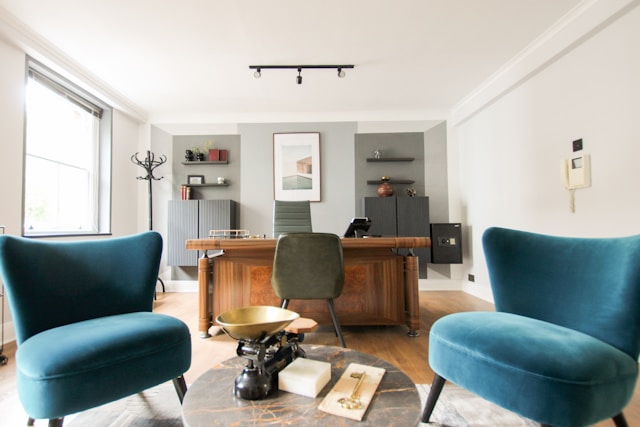Equipping your office with the right furniture is essential for creating a productive and comfortable work environment. You want to focus on selecting pieces that balance functionality with style, ensuring that every item complements your workflow and office aesthetics. Whether you are setting up a home workspace or revamping a corporate office, the key is to choose furniture that reflects your personal needs while enhancing efficiency and providing ergonomic support for long hours of work.
Prioritize Ergonomics
Ergonomics play a crucial role in maintaining health, comfort, and productivity in the workplace. Choosing office furniture with a focus on ergonomics helps prevent musculoskeletal disorders and reduces the risk of physical strain caused by long hours of sitting or repetitive movements. An ergonomic chair, for instance, should have adjustable height, lumbar support, and proper cushioning to promote good posture and minimize back pain. Likewise, modern office desks should be adjustable or of an appropriate height to prevent strain on the wrists and arms. This combination ensures that employees can work comfortably and efficiently throughout the day.
To ensure ergonomics are prioritized, consider furniture that can be customized to the user’s specific needs, and encourage regular assessments to make necessary adjustments. Investing in ergonomic furniture not only enhances the well-being of employees but also boosts their performance and overall job satisfaction, contributing to a healthier and more efficient work environment.
Plan for Space Efficiency
Space efficiency is vital in maximizing the functionality of an office, especially in smaller spaces, where every inch counts. Efficient use of space can improve workflow, enhance collaboration, and create an inviting atmosphere. To achieve space efficiency, start by assessing the specific needs of your office environment. Identify the essential furniture pieces and avoid unnecessary clutter. Consider using multi-functional items, like desks with built-in storage or foldable tables, to optimize space usage.
Modular furniture that can be easily reconfigured is also ideal for adapting to changing needs. Strategic placement of furniture can create natural pathways and open areas, fostering a more dynamic work setting. Additionally, maintaining an organized space with proper storage solutions prevents overcrowding. Overall, a well-planned, space-efficient office not only enhances productivity but also contributes to a pleasant and stress-free environment.
Consider Flexibility
Flexibility is one of the greatest benefits of modern office furniture and there are various ways to incorporate it into your workspace. Look for the following:
- Adjustable desks
- Modula furniture
- Movable partitions
- Flexible seating options
- Foldable or collapsible furniture
- Rolling furniture
- Convertible furniture
- Hot desking
This allows businesses to quickly adapt to changing operational needs and technological advancements. In dynamic work environments, flexible furniture can easily be reconfigured to support collaborative work, individual focus, or spontaneous meetings. This versatility fosters innovation and creativity by enabling employees to customize their workspace according to the task at hand.
Moreover, flexible furniture supports a diverse workforce, accommodating different work styles and ergonomic preferences. It can also facilitate a smooth transition between in-person and remote work setups. Ultimately, investing in flexible office furniture results in a versatile, adaptable workspace that boosts productivity, employee satisfaction, and operational efficiency.
Choose Quality over Quantity
Good furniture ensures durability, comfort, and long-term value, outweighing the appeal of filling an office with cheaper alternatives. High-quality furniture is crafted with superior materials and workmanship, designed to withstand daily use and maintain its functionality and aesthetics over time. This reduces the need for frequent replacements, thus saving costs and minimizing waste in the long run. Prioritizing quality over quantity means carefully selecting fewer, well-made pieces that fulfill both practical needs and design preferences.
To emphasize quality, assess the durability, warranty, and user reviews of furniture options. Opt for trusted brands known for their commitment to excellence, and focus on pieces that offer comfort and ergonomic support. By adopting this approach, you create a more professional, inviting workspace conducive to productivity and employee satisfaction.
Ensure Adequate Storage
Proper storage solutions help maintain an organized, clutter-free workspace, which significantly enhances productivity and efficiency. Without proper storage, offices can quickly become disorganized, leading to lost documents and reduced workflow. When planning for storage, consider the specific needs of your workspace and the type of items to be stored. Opt for versatile storage furniture, such as filing cabinets with lockable drawers for important documents, bookshelves for resources, and storage bins for miscellaneous items.
Use vertical space to maximize room efficiency and keep valuable floor space free for other activities. Evaluate options like modular storage units, which can be adapted and expanded as needs change. Properly designed storage solutions not only promote tidiness but also contribute to a more productive and pleasant work environment.
Focus on Aesthetics and Branding
The visual appeal of office furniture contributes to the overall ambiance and can significantly impact employee morale and client perceptions. Choosing furniture that aligns with brand identity helps reinforce the company’s values and ethos, making it memorable to visitors and consistent for employees.
To synchronize aesthetics and branding, select colors, materials, and designs that reflect the company’s image and culture. For example, a modern tech firm might opt for sleek, minimalist furniture, while a traditional law office could prefer classic, wooden pieces. Consistent branding through furniture choice fosters a unified look and feel, enhancing brand recognition and creating a strong corporate image that resonates with both employees and clients.
Don’t Forget About Technology Integration
Tech integration is vital when selecting office furniture, as it supports seamless workflows and enhances productivity. By prioritizing furniture that accommodates these needs, such as cable management systems, built-in charging ports, and adjustable monitor stands, businesses can ensure a clutter-free, efficient workspace. Ergonomically designed furniture that considers device usage mitigates the risk of strain and discomfort, allowing employees to work with modern-day tools comfortably.
Furthermore, furniture equipped to handle future technological advancements ensures adaptability and sustainability. To prioritize integration, assess how technology is used within the office and select pieces that facilitate these requirements. Look for multi-functional furniture that supports various devices, and consider customizable solutions that allow easy updates, ensuring your workspace stays ahead in an ever-evolving tech landscape.
In evaluating your office furniture choices, remember that the right selection can enhance productivity, wellness, and creativity. Prioritize ergonomics, space optimization, and flexibility while never compromising on quality and aesthetics. Consider how technology integrates with your setups, reflecting brand identity and embracing modern adaptability. This thoughtful approach will help you design an inspiring and efficient work environment that nurtures both your workforce and business success.


